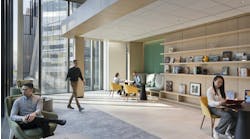Advances in technology drive demand for intelligent building systems and put a spotlight on the growth of smart lighting control solutions. By integrating connected, digital lighting into building and renovation projects, engineers, designers, and contractors can deliver high-value, energy efficient, sustainable, and comfortable spaces for building owners and occupants.
The impact of smart lighting is directly linked to the evolution of LEDs. As efficient and versatile LEDs replaced fluorescent lighting in commercial projects, lighting professionals were able to use digital control technology to design personal, dynamic, and human-centric lighting systems. The result is integrated, high-performance dimming, automated shading, and tunable white solutions in spaces that are beautiful and inviting, as well as efficient and future-proof. Flexible, connected lighting systems are essential for smart buildings to be groundbreaking the moment their doors first open and to improve over time.
Smart, connected lighting systems that enhance building performance as well as the occupant experience can accomplish the following:
- Increase sustainability and energy efficiency without sacrificing comfort or control.
- Collect data and improve real estate value by delivering space-utilization insights.
- Empower a human-centric environment that enhances well-being, productivity, and value.
LLLCs forFlexible and energy efficient smart systems
Smart lighting control solutions ensure the ability to specify systems that support the latest energy codes, accommodate budget constraints, and give customers the flexibility to easily adjust system programming and performance as requirements change over time.
A growing number of wireless options, including systems that incorporate luminaire level lighting controls (LLLCs), allow lighting systems to scale easily and almost infinitely. These systems offer zone-based control for large, open areas as well as individual fixture control for enhanced capability, comfort, and design freedom. While wired, fixture-level control has been possible for more than a decade, wireless technology now puts versatile smart control well within reach for most projects from both a budgetary and scheduling perspective.
Systems that include LLLCs magnify the power of smart LEDs, integrating the benefits of a large, networked control system directly into the individual LED fixtures. For small offices, retail or hospitality spaces, or large, multiuse commercial buildings, individual fixture control can deliver programming versatility. Collected occupant data, combined with the ability to rezone or reprogram lighting without rewiring or disruption to the space, contributes to more efficient lighting strategies over the life of the building.
How do LLLCs increase the versatility of a lighting control system? Occupancy sensors and daylight sensors can be designed directly into the LLLC device, or the fixture can communicate with system sensors in each building area or zone to automatically adjust lighting based on sensor data—critical for meeting a variety of energy and building codes. System software can then use that data to help the facilities team manage energy use, make the most of natural daylight in a space, and inform building management decisions.
The result is a system that evolves and can overcome changes during and post construction—even when the system is already fully programmed. This makes the project engineer’s job simpler and also less risky; additionally, the added versatility is equally important to the owner or tenant who can now use fixture-level occupant data to improve the comfort, efficiency, and even value of their space.
Cloud-connected control for longevity
Building owners and facility managers are increasingly looking to lighting system data for actionable insights about how systems and structures can best support business goals and operations. This information has potential to aid in employee recruitment and retention, inform better space planning, and enhance real estate over time. Connected, wireless lighting control solutions can flex over time to deliver systems that evolve to meet the current and future needs of any space.
While cloud-connected technology may seem like a paradigm shift in lighting control, it is commonplace in our everyday lives. When we buy laptops and mobile phones, we invest in the hardware with the expectation that functionality-improving updates will be delivered regularly and automatically via cloud updates. Physical hardware is the front end, and we count on it becoming smarter and more capable as software and firmware are enhanced.
In an era when building technology can struggle to keep pace with innovation, connected lighting controls will receive regular software updates, ensuring the system gains functionality and capability over time.
This is also the promise of connected lighting control—the ability to make changes right from smart phone apps with confidence that new capabilities are just a cloud update away. With the right lighting system, the built environment becomes more dynamic and sustainable, enhances well-being, and provides the data and insights that drive operational improvements.
Sustainability and well-being: Optimizing the user experience
The past few years have underscored the importance of well-being in the workplace and other commercial spaces. Design frameworks encourage a culture of well-being and may help employers attract and retain high-caliber talent. This is all good news for owners looking to differentiate their properties in a competitive real estate market.
Lighting is functional and necessary; it is ubiquitous in any indoor space. But lighting also has the power to be an attractive building amenity, a means to more resilient spaces, and a system that continues to enhance building value over time. As your commercial buildings evolve, look for digital and wireless lighting and shading solutions that welcome people into the space.
Invest in smart lighting control solutions that augment natural daylight with state-of-the-art technologies, such as integrated shading solutions that balance automated daylight control and smart, dynamic lighting to increase occupant comfort, promote views, reduce glare, and meet energy reduction goals. Combined, these strategies make the most of electrical lighting systems while bringing the outdoors inside to create an engaging building environment.
Ensuring building owners and their tenants get the robust lighting performance they want and demand requires an ongoing commitment of support from your system manufacturers. Think of lighting control as part of the total property package. Embrace systems that suit individual styles and tasks while contributing to the resilience, flexibility, and well-being of your commercial space. Work with manufacturers with a proven history of innovation and customer care that can help you think through desired system performance from initial design to system commissioning for years into the future.
Chris Udall is a senior product manager at Lutron Electronics.
For more news, projects, and profiles in the smart buildings ecosystem, subscribe to the SBT newsletter and follow us on LinkedIn, Twitter, and Facebook.



